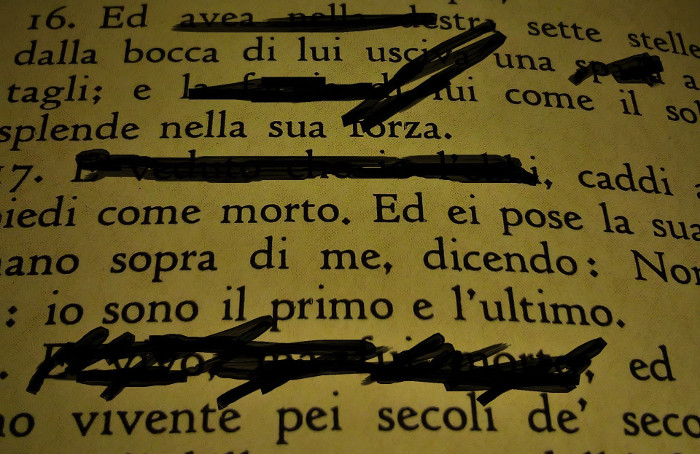Geopolitica della verecondia, o Stalin il Braghettone: censura politica e censura moralizzatrice in URSS
Abstract
Due leggi recentemente discusse al parlamento russo, tese a punire le oscenità anche nelle opere letterarie e l'uso “ingiustificato” di parole straniere, sono un'occasione per indagare il rapporto tra censura politica e censura moralistica, di cui è ben nota l'importanza nel periodo stalinista e poststalinista, ma il cui legame è stato raramente considerato.
Se per quanto riguarda la censura politica non resta molto da scoprire, lo straordinario moralismo del regime sovietico a partire dagli anni Trenta contiene elementi di contraddizione tanto con tensioni verso la liberazione dei costumi presenti nel discorso bolscevico del periodo precedente quanto con la retorica dell'”uomo nuovo” che si andava sviluppando negli stessi anni.
Una prima spiegazione può essere rintracciata nel noto riaffiorare di valori “borghesi” nella società stalinista; l'estremismo della censura è legato piuttosto alla peculiare poetica del realismo socialista: l'arte, in quel sistema, è considerata strumento di azione diretta sulla psiche del percettore, la contemplazione astratta è bandita per principio, e dunque la classica giustificazione del nudo è inapplicabile.Downloads
Riferimenti bibliografici
Bajazitova, Aleksandra, “Na 100-rublevoj kupjure v Gosdume razgljadely 'pornografiju'”, Izvestija.ru, 8.7.2014, http://izvestia.ru/news/573537, online (ultimo accesso 02/01/2015).
Bljum, Arlen, Za kulisami "Ministerstva pravdy": Tajnaja istorija sovetskoj cenzury 1917-1929, Sankt Peterburg, Akademičeskij proekt, 1994.
Bljum, Arlen, Sovetskaja cenzura v epochu total’nogo terrora. 1929-1953, Sankt-Peterburg, Akademičeskij proekt, 2000.
Bljum, Arlen, Zapreščennye knigi russkich pisatelej i literaturovedov. 1917-1991: Indeks sovetskoj cenzury s kommentarijami, Sankt-Peterburg., Sankt-Peterburgskij gos. un-t kul’tury i iskusstv, 2003.
Bourdieau, Pierre, La distinction (1979), trad. it. La distinzione: Critica sociale del gusto, Bologna, il Mulino, 1983.
Boym, Svetlana, Common Places: Mythologies of Everyday Life in Russia, Cambridge, MA, and London, Harvard University Press, 1994.
Britlinger, Angela, “Back in the U**R: Russia's New Profanity Wars”, NYU Jordan Center for the Advanced Study of Russia: News, 12.5.2014,http://jordanrussiacenter.org/news/back-ur-russias-new-profanity-wars/#.VDlwYlc0-aQ, online (ultimo accesso 02/01/2015).
Carleton, Gregory, Sexual Revolution in Bolshevik Russia,Pittsburgh, University of Pittsburgh Press, 2005.
Clark, Kenneth, The Nude: A study of Ideal Art, London, Murray, 1956 trad. it. Il nudo: uno studio della forma ideale, Vicenza, Neri Pozza, 1995.
Colombo, Duccio, “Il realismo socialista e il GULag: estetica normativa e censura”, Leggere la cenere: Saggi su letteratura e censura, Ed. R. Francavilla, Roma, Artemide, 2009: 119-130.
Depretto, Catherine, “La censure à la période soviétique (1917-1953): état de la recherche”, Revue des Études slaves, 73.4 (2001): 655-656.
Dunham, Vera S., In Stalin's Time: Middleclass Values in Soviet Fiction, Cambridge and New York, Cambridge University Press, 1976.
Fitzpatrick, Sheila, Everyday Stalinism: Ordinary Life in Extraordinary Times: Soviet Russia in the 1930s, Oxford and New York, Oxford University Press, 1999.
Foucault, Michel, La volonté de savoir (1976), trad. it. La volontà di sapere: Storia della sessualità I, Milano, Feltrinelli, 19883.
Goldman, Wendy Z., Women, the State and Revolution: Soviet Family Policy and Social Life, 1917-1936, Cambridge and New York, Cambridge University Press, 1993.
Golomstock, Igor, Totalitarian Art: in the Soviet Union, the Third Reich, Fascist Italy and the People's Republic of China, London, Collins Harvill, 1990, trad. it. Arte totalitaria: nell'URSS di Stalin, nella Germania di Hitler, nell'Italia di Mussolini e nella Cina di Mao, Milano, Leonardo, 1990.
Gor'kij, Maksim, Sobranie sočinenij v tridcati tomach: t. 27: Statʹi, doklady, reči, privetstvija : 1933-1936, Moskva, GIChL, 1953.
Heller, Leonid – Lahusen, Thomas, “Palimpsexes: Les Métamorphoses de la thématique sexuelle dans le roman de F. Gladkov Le Ciment: Notes pour une approche analytico-intérpretative de la littérature soviétique”, Wiener Slawistischer Almanach, 15 (1985): 211-54.
Kaganovsky, Lilya, How the Soviet Man was Unmade: Cultural Fantasy and Male Subjectivity under Stalin, Pittsburgh, University of Pittsburgh Press, 2008.
Kendrick, Walter, The Secret Museum: Pornography in Modern Culture, New York, Viking Press, 1987.
Kočetov, Vsevolod, Čego že ty chočeš'? (1969), trad. it. Ma, insomma, che cosa vuoi?, Ed. Vittorio Strada, Roma, Samonà e Savelli, 1970.
Kon, Igor, “Sexual minorities”, Sex and Russian Society, Eds. Igor Kon - James Riordan, London, Pluto, 1993: 89-115.
Kon, Igor', “Obnažennoe mužskoe telo v russkom izobrazitel'nom iskusstve”, Telo v russkoj kul'ture, Eds. G.I. Kabakova – F. Kont, Moskva, Novoe literaturnoe obozrenie, 2005: 194-222.
Levčenko, Jan, “A nu-ka, povtori!”, Gazeta.ru, 01.07.2014, http://www.gazeta.ru/comments/2014/06/30_a_6092109.shtml, online (ultimo accesso 02/01/2015).
Markelova, Marina, “Kuda delos' dostoinstvo Bol'šogo, ili začem Apollony figovyj listok?”, Argumenty i fakty – AiF.ru, 7.11.2011, http://www.aif.ru/culture/29032, online (ultimo accesso 10/01/2015).
Mosse, George L., Nationalism and Sexuality: Respectability and Abnormal Sexuality in modern Europe, New York, Howard Fertig, 1985.
Naiman, Eric, Sex in public: the incarnation of early Soviet ideology, Princeton, Princeton University Press, 1997.
Nead, Lynda, The Female Nude: Art, Obscenity and Sexuality, London and New York, Routledge, 1992.
“Ob utračennom mužskom dostoinstve glavnogo simvola imperii”, Muzej imeni Andreja Rubleva i ego obitateli, 13.11.2011, http://expertmus.livejournal.com/2011/11/13/, online (ultimo accesso 10/01/2015).
Papernyj, Vladimir, Kul'tura Dva, Moskva, Novoe literaturnoe obozrenie, 20062.
Pervyj vsesojuznyj s''ezd sovetskich pisatelej: 1934: Stenografičeskij otčet, Moskva, GIChL, 1934; reprint: Moskva, Sovetskij pisatel', 1990.
Piretto, Gian Piero, Gli occhi di Stalin: La cultura visuale sovietica nell'era staliniana, Milano, Raffaello Cortina, 2010.
Reid, Susan E., “In the Name of the People: The Manège Affair Revisited”, Kritika: Explorations in Russian and Eurasian History 6.4 (2005): 673-716.
Simpson, Pat, “The New Person's body: drapery and disclosure in Stalinist monumental sculpture 1937-44”, Sculpture journal 15.1 (2006): 36-51.
Ševcov, Ivan, Tlja: Antisionitskij roman, Moskva, Institut russkoj civilizacii, 2014.
Zalambani, Maria, Censura, istituzioni e politica letteraria in URSS (1964-1985), Firenze, Firenze University Press, 2009.
Zolotonosov, Michail, Slovo i Telo: Seksual'nye aspetky, universalii, interpretacii russkogo kul'turnogo teksta XIX-XX vekov, Moskva, Ladomir, 1999.
Informazioni sul copyright
Questa licenza permette a terzi di riprodurre, distribuire, comunicare al pubblico, esporre in pubblico, rappresentare, eseguire, recitare e modificare quest'opera, purché vengano citati l'autore e la rivista. Questa è la più ampia tra le licenze Creative Commons, rispetto alle libertà concesse a terzi sulle opere licenziate sotto Attribuzione.









